
Wayne is a village in DuPage and Kane counties, Illinois, United States. The eastern portion, in DuPage County, is in Wayne Township, while the western portion, in Kane County, is in St. Charles Township. The population was 2,286 as of the 2020 census.

Georgetown is a city in Texas and the county seat of Williamson County, Texas, United States. The population was 67,176 at the 2020 census, and according to 2023 census estimates, the city is estimated to have a population of 96,312. It is 30 miles (48 km) north of Austin and is part of the Austin–Round Rock–San Marcos metropolitan statistical area.
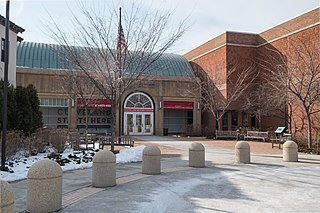
The Western Reserve Historical Society (WRHS) is a historical society in Cleveland, Ohio. The society operates the Cleveland History Center, a collection of museums in University Circle.
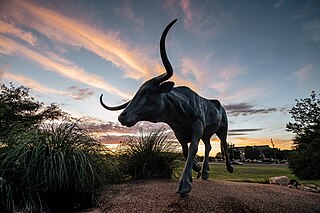
The National Ranching Heritage Center, located on the Texas Tech University campus in Lubbock, Texas, is a unique museum dedicated to preserving and celebrating the history and heritage of ranching in the United States. Established in 1971, the center sits on a 27-acre historical park and features a collection of authentic ranching structures ranging from the 1780s to 1950s that tell the story of ranching in North America.

The Museum of Appalachia, located in Norris, Tennessee, 20 miles (32 km) north of Knoxville, is a living history museum that interprets the pioneer and early 20th-century period of the Southern Appalachian region of the United States. Recently named an Affiliate of the Smithsonian Institution, the museum is a collection of more than 30 historic buildings rescued from neglect and decay and gathered onto 63 acres (25 ha) of picturesque pastures and fields. The museum also preserves and displays thousands of authentic relics, maintains one of the nation's largest folk art collections, and hosts performances of traditional Appalachian music and annual demonstrations by hundreds of regional craftsmen.

The Mabee House, on the grounds of the Mabee Farm Historic Site,, is the oldest house still standing in the Mohawk Valley. It is located in the town of Rotterdam, New York, in the hamlet of Rotterdam Junction, New York, along New York State Highway 5S, about six miles (9.7 km) west of the city of Schenectady.

Kings Mountain State Park is a South Carolina state park located in the Piedmont region of South Carolina. It is situated in York County near the city of Blacksburg, about 40 miles (64 km) southwest of Charlotte, North Carolina near Interstate 85.

Lyndon B. Johnson State Park and Historic Site is a state park located along the Pedernales River in Gillespie County, Texas, United States west of Johnson City and east of Fredericksburg. The state created the park with donated land to honor Lyndon B. Johnson as a "national and world leader." The park opened to the public in 1970 and is managed by the Texas Parks and Wildlife Department.

The Garfield Farm and Inn Museum is a Registered Historic Place in Kane County, Illinois, United States. The property is a 375-acre (1.52 km2) farmstead, centered on an inn that served teamsters and the nearby community during the 1840s. It is currently a museum offering a variety of educational and entertainment events. The buildings that remain are three original 1840s structures, including the 1842 hay and grain barn, the 1849 horse barn, and the 1846 inn. Various other barns and outbuildings also stand, the last dated to 1906.
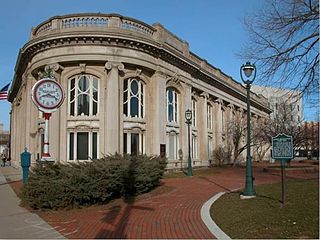
The Milwaukee County Historical Society, also known as MCHS, is a local historical society in Milwaukee County, Wisconsin. Founded in 1935, the organization was formed to preserve, collect, recognize, and make available materials related to Milwaukee County history. It is located in downtown Milwaukee in the former Second Ward Savings Bank building.

Old Cowtown Museum is an accredited history museum located in Wichita, Kansas, United States. It is located next to the Arkansas River in central Wichita. The Museum was established in 1952, and is one of the oldest open-air history museums in central United States with 54 historic and re-created buildings, including a period farm and out-buildings, situated on 23 acres of land off the original Chisholm Trail. Cowtown is a combination of attraction, museum, living history site, and historic preservation project. The City of Wichita works with the Historic Wichita Cowtown, Inc. Board, a 501(c)(3) not-for-profit organization, to further the Museum and its mission.
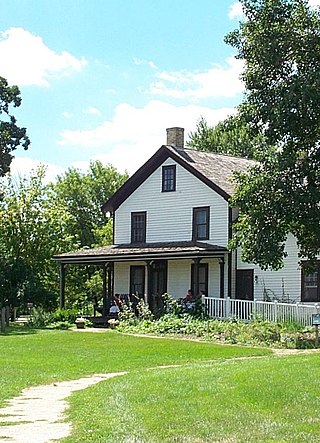
The Gibbs Farm is a museum in Falcon Heights, Minnesota, United States. The site was once the farmstead of Heman and Jane Gibbs, first built in 1854; the existing farmhouse includes the small, original cabin. The museum seeks to educate visitors on the lives of 19th-century Minnesota pioneers and the Dakota people who lived in southern Minnesota before the arrival of Europeans.

The dogtrot, also known as a breezeway house, dog-run, or possum-trot, is a style of house that was common throughout the Southeastern United States during the 19th and early 20th centuries. Some theories place its origins in the southern Appalachian Mountains. Some scholars believe the style developed in the post-Revolution frontiers of Kentucky and Tennessee. Others note its presence in the South Carolina Lowcountry from an early period. The main style point was a large breezeway through the center of the house to cool occupants in the hot southern climate.
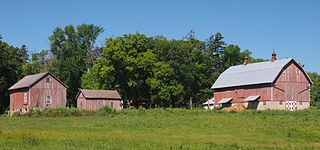
The Andrew Peterson Farmstead is a farm just east of Waconia, Minnesota, United States. The farm is located in rural Carver County, Minnesota, on Minnesota State Highway 5. The farm is listed on the National Register of Historic Places for its association with its first owner, Andrew Peterson. It is owned and operated by the Carver County Historical Society.

Fanshawe Pioneer Village is an open-air museum established in 1959 and located in the Fanshawe Conservation Area in London, Ontario. The village uses historical re-enactments to communicate the history of rural communities in the former townships of Westminster, London, North Dorchester, Delaware, West Nissouri and Lobo in Middlesex County from 1820 to 1920 and the founding and development of the City of London up to 1840.

The Stamford Museum & Nature Center, located in Stamford, Connecticut, is an art, history, nature, and agricultural sciences museum. The property covers 118 acres beginning about half a mile north of the Merritt Parkway. It was originally a private estate.

The Wood County Museum, located in Bowling Green, Ohio, is the original site of the Wood County Infirmary also known as the Wood County Home or the Poor Farm. This structure was the home to poor, mentally- ill, physically disabled and anyone in need of public assistance who were residents of Wood County.

Sproul House a Stick Style, Victorian farm house built in 1870 in the present-day City of Norwalk in Los Angeles County, California by the founder of the city for himself and his family. It houses the Gilbert Sproul Museum containing the family's original furniture, much of which dates back to 1870, along with one-of-a-kind materials relating to the history of Norwalk, such as maps, early school pictures, and other city photographs. In addition, there are displays of historical dolls, guns, and a rare collection of First Nations artefacts.




















